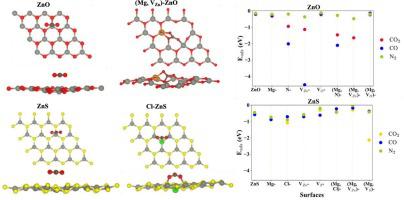Sensing and Bio-Sensing Research Pub Date : 2023-11-03 , DOI: 10.1016/j.sbsr.2023.100600 Pornsawan Sikam , Sireetone Yawirach , Anucha Watcharapasorn , Thanayut Kaewmaraya , Pairot Moontragoon

|
This work aims to design two-dimensional (2D) catalysts based ZnO and ZnS for CO2 reduction reaction (CRR), nitrogen reduction reaction (NRR), CO2 and N2 captures and sensors. Cheap and abundant elements which are Mg, Cl, and N are doped into Zn, S, and O sites to tune the electronic properties of the ZnO and ZnS monolayers. Also, influences of O, S and Zn vacancies on the electronic properties and gas adsorption are examined as well. Adsorption energy, interaction energy, distortion energy, density of states, Bader charge, shift of Fermi level, and work function of the modified surfaces are studied via density functional theory (DFT) performed on VASP. From the results, Mg, Cl, and N doping as well as vacant sites can extremely change electronic properties, i.e., semiconductive to metallic behavior, the shift of Fermi level and the variation of work function. Some modified ZnS and ZnO monolayers can be good candidates CRR and NRR catalysts since neither too strong nor too light binding of CO2, CO and N2. The best catalysts for this study is (Mg, VZn)-ZnO and Cl-ZnS because both can be sensors and electrochemical catalysts due to the proper binding strength for CO2, CO and N2 adsorption. The change in the electronic properties leading to the change in gas adsorption shows that the ZnO and ZnS modification by cheap-element doping and vacancy-site creation are potential ways to improve their properties, extend their applications and lead to the invention promising catalysts for electrochemical reactions, gas sensors and gas storages.
中文翻译:

通过引入缺陷和替代功能化,针对 CO2、CO 和 N2 调整 ZnO 和 ZnS 单层的气敏特性
本工作旨在设计基于ZnO和ZnS的二维(2D)催化剂,用于CO 2还原反应(CRR)、氮还原反应(NRR)、CO 2和N 2捕获和传感器。将廉价且丰富的元素 Mg、Cl 和 N 掺杂到 Zn、S 和 O 位点中,以调节 ZnO 和 ZnS 单层的电子性能。此外,还研究了 O、S 和 Zn 空位对电子性能和气体吸附的影响。通过在 VASP 上执行的密度泛函理论 (DFT) 研究了修饰表面的吸附能、相互作用能、畸变能、态密度、Bader 电荷、费米能级位移和功函数。结果表明,Mg、Cl和N掺杂以及空位可以极大地改变电子特性,即半导体到金属的行为、费米能级的移动和功函数的变化。一些改性ZnS和ZnO单层可以作为CRR和NRR催化剂的良好候选者,因为与CO 2、CO和N 2的结合既不太强也不太轻。本研究的最佳催化剂是(Mg, V Zn )-ZnO 和Cl-ZnS,因为它们对于CO 2、CO 和N 2吸附具有适当的结合强度,因此两者都可以作为传感器和电化学催化剂。电子性质的变化导致气体吸附的变化表明,通过廉价元素掺杂和空位位创建对 ZnO 和 ZnS 进行改性是改善其性能、扩展其应用的潜在途径,并导致发明有前景的电化学催化剂。反应、气体传感器和气体储存。



























 京公网安备 11010802027423号
京公网安备 11010802027423号